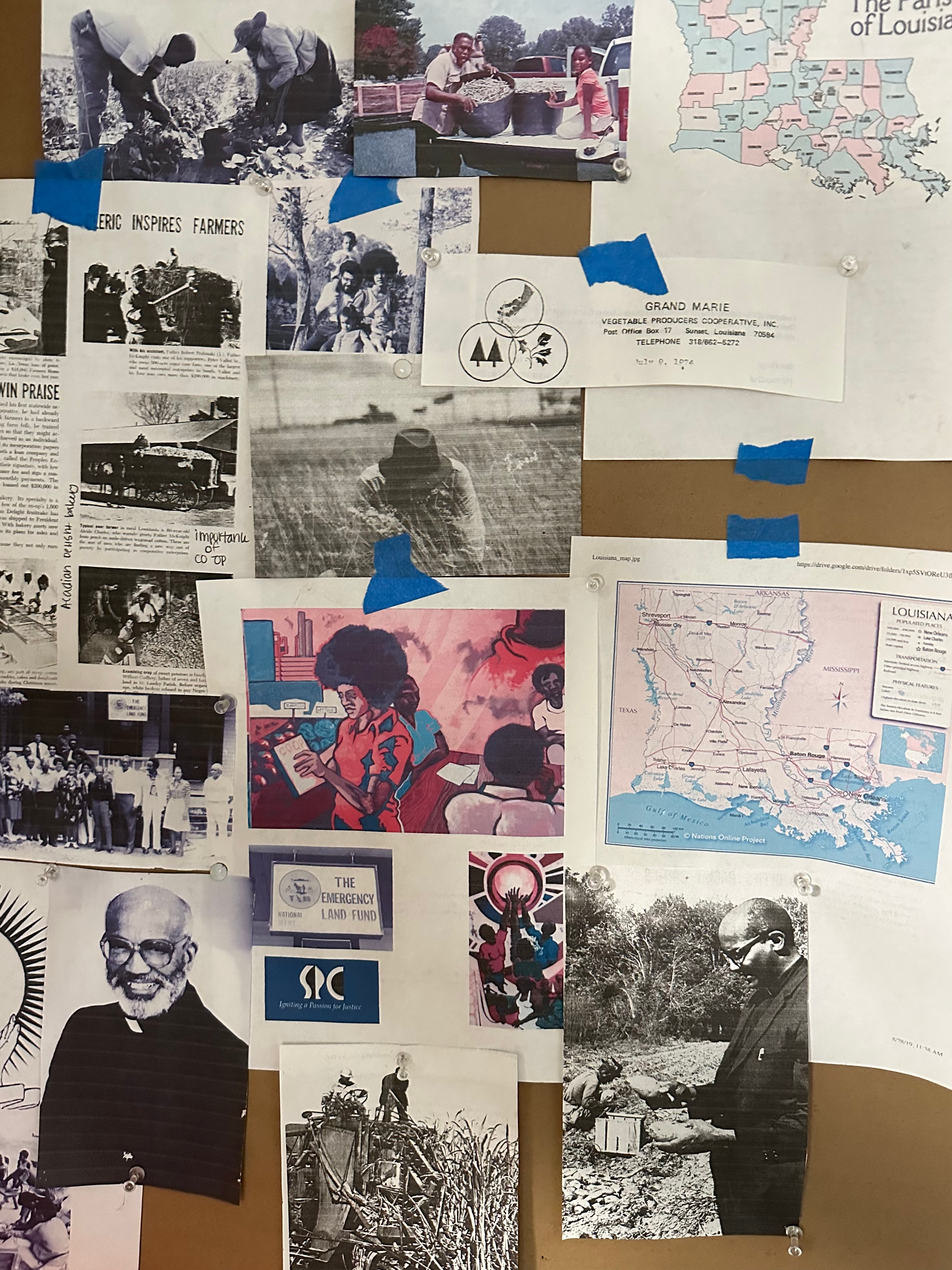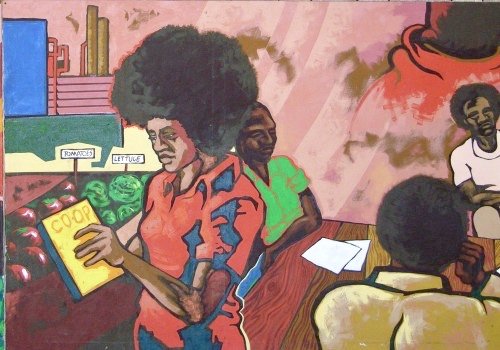Part 1: A Brief History of Louisiana Black Farming Cooperatives
A snapshot of our research notes.
Throughout 2019 we researched the history of Louisiana’s Black cooperatives. Prior to the global pandemic we had plans of traveling across Louisiana speaking with cooperative members and farmers. Oral tradition is one of the greatest forms of history/truth-telling and we will find a way to make this happen in the future. We’ll include links to videos and articles from the past and present so you are able to get a better understanding of the power of Black farming, cooperatives, and alternative economics.
We have hopes of turning this research and reflection into print form at some point. For now, we wanted to share what we’ve learned and discovered.
As a reminder this is a very rough work in progress, but as a creative studio we love to share our process. You’ll find a few excerpts from our writings+ discoveries below:
Part of Donald Lee “Aldox” Alexander’s mural at the Federation of Southern Cooperatives headquarters. Aldox was a well-recognized Southwest Louisiana artist, designer, and musician.
An Introduction
What do you think of when you hear Civil Rights Movement? Do you think of farming - a largely forgotten and still relevant movement focused on agriculture, Black land ownership, entrepreneurship, and community. Stemming from Fannie Lou Hamer’s Freedom Farmers Cooperative the message of collective agency and community resilience spread across the Southern states and found a home in Louisiana.
In these writings you’ll discover a rich, yet untold history of resistance through agriculture. In the 1950’s - present day Black farmers united against white power structures to provide not only sustenance for their families but a means of survival. Louisiana cooperatives faced many hardships in the form of racism, discrimination, violence, and financial and natural disaster. These cooperatives also faced entrepreneurial success, community building, skill sharing, and shifts in power. Many are still progressing today and continuing to fight against the same white power structures that have plagued generations.
While this expansive history is rich and deeply rooted, we were able to only scratch the surface of Black cooperatives in Louisiana. We were able to collect snapshots from archival research. A majority of the information comes from newspaper and journal articles, correspondence written and received by cooperative members, and archives of cooperative organizations. A very special shoutout and thank you to the Amistad Research Center and the Schomburg Center for Research in Black Culture for your support and space.
Throughout your reading, please find moments to pause, observe, and reflect. We ask that you take the time to connect not only with the stories and faces, but your own knowledge of agriculture, cooperatives, and the Black experience.
Atlantic City, NJ, August 10, 1964. The 1964 Democratic Convention. Mississippi Freedom Democratic Party delegates challenges Mississippi Democrats. Fannie Lou Hamer, center, sings during a MFDP rally on the boardwalk, along with, from left, Emory Harris, Stokely Carmichael (straw hat), Sam Block, Eleanor Holmes Norton, and Ella Baker. Image credit: KPBS.
What is a Cooperative?
In 1965, cooperatives began springing up in the South among Black and low-income rural people. Members pooled resources, mutually assisted each other, and sought outside funding. Cooperatives were not just for farming they included: baked goods, machinery and equipment, sewing/fabrics, land ownership, and professional development. “A cooperative was viewed as the basis of self-determination and resistance”, according to Monica M. White author of Freedom Farmers: Agricultural Resistance and the Black Freedom Movement.
Organizers and members believed in education and training. They provided additional services to their communities and often stabilized them. Black people throughout the diaspora maintained values of mutual support and cooperation .
However there was some pushback with cooperatives. They could only help a fraction of those dispossessed from their homes and livelihood. Not everyone was on board for this alternate form of economics. Many Black people viewed farming and agriculture as oppressive and exploitive. There have been failures and setbacks - often because of lack of resources (capitalization), lack of enough specific management experience and training, and poor business planning. There were also acts of sabotage - rent increases, withdrawn or unaffordable insurance, unfair competition, physical harassment to persons and property.
While at first the Black cooperative movement seemed to have been small and inconsequential as well as little acknowledged, it has actually played a part in many of the major movements for Black liberation in the United States. For some reason, there is not as strong a collective memory about the cooperative efforts that succeeded.
Federation of Southern Cooperatives & Land Assistance
F
und logo.
Notes from Freedom Farmers: Collective Agency and Community Resilience
This is a history that is often overlooked or shrouded in the oppressiveness of slavery. Freedom Farmers by Monica M. White is a resource focused on the Black working-class role in liberating those who are closest to the land. As noted in Freedom Farmers, cooperatives can be viewed as “southern rural resistance” to the oppressive white structures during the Civil Rights era.
Southern cooperatives were created as “community development efforts as a strategy for resistance”. These cooperatives allowed Black people in the rural South “freedom to participate in the political process, to engage in an economic model that was cooperative and fair, and to exchange ideas with others who shared their goals”. These organizations offered innovative, liberating approaches and practices to provide a self-sufficient community. More than just agriculture, cooperatives provided the foundation for sustainable communities.
Monica M. White theorized collective agency and community resilience (CACR) are the “framework that builds upon and amplifies the social movement concept of everyday strategies of resistance”. This theory is the foundation for alternate community structures, like cooperatives - - focused on professional development, knowledge, skills, and economic independence.
According to White, collective agency is the ability for people to develop and execute behavioral options to improve their political future. For those engaged in collective agency, the idea of only the individual well-being gives way to community well-being. Community resilience focuses on “community-based forms of social organization” that strategize around violence, environmental change, and other forms of human/natural disaster.
Before the formation of cooperatives, CACR manifested itself in the form of slave gardens, The Colored Farmers Alliance, and The Universal Negro Improvement Association. While each of these forms of organized resistance are important in the history of Black liberation, we have many pages to cover on Southern cooperatives based in Louisiana. We also can not continue this “book” without acknowledging Fannie Lou Hamer and the revolutionary - Freedom Farmers Cooperative based out of the Mississippi Delta.
White Opposition to Black Cooperatives
An excerpt from a May 1968 Ebony feature on Southern Black cooperatives:
“There is a close connection between economic control and political participation, for those who control the financial processes of a region also control the politics. The poor, in acquiring economic prestige, acquire a greater voice in politics and a freer rein to exercise their rights.”
White farmers, landowners, and business men did not like Black farmers having any type of political autonomy and sought to destroy and minimize any of their political efforts. They saw cooperatives as a means of political power and tried to sabotage them through financial means specifically. Cooperatives were a force that could pushback against oppressive political power - the threat to white power structures was real. There are many instances of local, state and the federal government attempts at discrediting and shutting down cooperatives. These will be detailed in the history of each highlighted cooperative.
Cooperatives You’ll Learn About:
In this series you’ll be introduced to the following cooperatives:
Federation of Southern Cooperatives
Southern Consumers Cooperative
Acadian Delight Bakery
Grand Marie Vegetable Producers Cooperative
Magnolia Produce Association, Inc. (Magnolia Vegetable Producers Co-op)
West Cattle Buyers Coop + North Caddo Food Producers
St. Landry Vegetable Growers Co-op
These early cooperatives led the groundwork for the success of current Southern cooperatives. Still functioning and flourishing, The Federation of Southern Cooperatives overseas cooperatives in all 13 Southern states.




